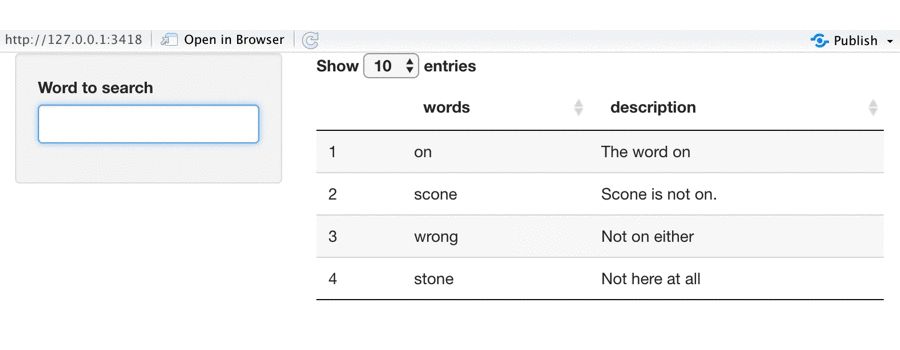еҹәдәҺжӯЈеҲҷиЎЁиҫҫејҸй«ҳдә®жҳҫзӨәDTдёӯзҡ„еҚ•иҜҚ
дҪҝз”ЁDTй—Әдә®пјҢжҲ‘еёҢжңӣиғҪеӨҹзӘҒеҮәжҳҫзӨәжүҖйҖүеҚ•иҜҚгҖӮи®ҫзҪ®searchHighlight = TRUEжҺҘиҝ‘жҲ‘жғіиҰҒзҡ„и®ҫзҪ®пјҢдҪҶиҝҷд№ҹдјҡзӘҒеҮәжҳҫзӨәеҢ…еҗ«жҗңзҙўзҡ„еҚ•иҜҚгҖӮдҫӢеҰӮпјҢеҰӮжһңжҲ‘иҰҒжҗңзҙўвҖң onвҖқпјҢе®ғд№ҹдјҡдёҺвҖң stoneвҖқеҢ№й…ҚпјҢзӘҒеҮәжҳҫзӨәдёӯй—ҙзҡ„вҖң onвҖқгҖӮ
зӨәдҫӢеӣҫеғҸпјҡ
жҲ‘еҸҜд»ҘдјҳеҢ–жҗңзҙўйҖүйЎ№пјҢдҪҝregex = TRUEдёҚеҸҳпјҢдҪҶжҳҜдёҚдјҡзӘҒеҮәжҳҫзӨәгҖӮдҫӢеҰӮпјҢеҰӮжһңжҲ‘жғідҪҝз”ЁвҖң on | inвҖқд№Ӣзұ»зҡ„жӯЈеҲҷиЎЁиҫҫејҸпјҢд№ҹжҳҜеҰӮжӯӨгҖӮ
зӨәдҫӢпјҲеҢ…жӢ¬жӯЈеҲҷиЎЁиҫҫејҸпјүпјҡ
library(shiny)
library(DT)
library(data.table)
example_data <- data.table(words = c("on", "scone", "wrong", "stone"),
description = c("The word on", "Scone is not on.", "Not on either", "Not here at all"))
ui = shinyUI(fluidPage(
sidebarLayout(
sidebarPanel(
textInput("word_select", label = "Word to search")
),
mainPanel(
dataTableOutput("word_searched")
)
)
))
server = shinyServer(function(input, output, session) {
output$word_searched <- renderDataTable({
datatable(
example_data,
options = list(searchHighlight = TRUE,
search = list(regex = TRUE,
search = paste0("\\b", tolower(input$word_select), "\\b")))
)
})
})
shinyApp(ui = ui, server = server)
DTе·ІйҖҡиҝҮеҸҚеә”жҖ§иЎЁиҫҫејҸиҝҮж»ӨеңЁеҚ•иҜҚдёҠпјҢеӣ жӯӨжүҖжңүеӯ—ж®өеҝ…е®ҡдјҡеҢ…еҗ«жүҖйҖүеҚ•иҜҚпјҢдҪҶжҲ‘еҸӘжҳҜжғійҒҝе…Қеј•иө·з”ЁжҲ·иҜҜд»Ҙдёәжӣҙй•ҝзҡ„еҚ•иҜҚиў«й”ҷиҜҜең°еҢ…еҗ«еңЁжҗңзҙўдёӯзҡ„еӣ°жғ‘гҖӮжҲ‘жІЎжңүеңЁзӨәдҫӢдёӯжү§иЎҢжӯӨж“ҚдҪңпјҢдҪҶеҸӘжҳҜзЎ®и®ӨиҝҷдёҚжҳҜжҲ‘е…іжіЁзҡ„е…ғзҙ гҖӮ
ж„ҹи°ўжӮЁзҡ„её®еҠ©гҖӮ
пјҲе·Ізј–иҫ‘пјҢеңЁзӨәдҫӢж•°жҚ®дёӯж·»еҠ дәҶеёҰжңүж ҮзӮ№з¬ҰеҸ·зҡ„еҚ•иҜҚзӨәдҫӢгҖӮпјү
2 дёӘзӯ”жЎҲ:
зӯ”жЎҲ 0 :(еҫ—еҲҶпјҡ1)
жӮЁеҸҜд»ҘеҲӣе»әдёҖдёӘreactiveе…ғзҙ пјҢиҖҢдёҚжҳҜдҫқйқ ж•°жҚ®иЎЁзҡ„жҗңзҙўеҠҹиғҪпјҢиҜҘе…ғзҙ йҰ–е…ҲжҢүиҫ“е…ҘиҝӣиЎҢиҝҮж»ӨпјҢ然еҗҺе°ҶеҢ№й…Қзҡ„еҚ•иҜҚжӣҝжҚўдёәеөҢе…ҘеңЁ<span style="background-color:yellow;">ж Үи®°дёӯзҡ„зӣёеҗҢеҚ•иҜҚгҖӮиҝҷж ·еҸҜд»ҘйҖҡиҝҮжӣҙеӨҚжқӮзҡ„жӯЈеҲҷиЎЁиҫҫејҸжҸҗдҫӣжӣҙеӨ§зҡ„жҗңзҙўзҒөжҙ»жҖ§гҖӮ
жӮЁйңҖиҰҒе°Ҷescape = Fж·»еҠ еҲ°datatableпјҢд»ҘдҫҝжӯЈзЎ®и§ЈйҮҠHTMLж Үи®°гҖӮжҲ‘е·Іе°Ҷoptions = list(dom = "lt")ж·»еҠ еҲ°datatableдёӯпјҢд»ҘеҲ йҷӨж•°жҚ®иЎЁзҡ„жҗңзҙўеӯ—ж®өпјҢ并е°ҶжіЁж„ҸеҠӣйӣҶдёӯеңЁе·Ұдҫ§зҡ„жҗңзҙўеӯ—ж®өдёҠгҖӮ
дҪҝиҝҮж»ӨжқЎд»¶дҝқжҢҒзӣёеҪ“жЁЎзіҠзҡ„зҠ¶жҖҒпјҢд»ҘйҳІжӯўиЎЁж¶ҲеӨұпјҢзӣҙеҲ°жүҫеҲ°е®ҢзҫҺзҡ„еҢ№й…Қдёәжӯў-д№ҹе°ұжҳҜиҜҙпјҢеҪ“жӮЁй”®е…ҘвҖң oвҖқж—¶пјҢиЎЁдёҚеә”ж¶ҲеӨұпјҢеӣ дёәжІЎжңүе®ҢзҫҺзҡ„еҢ№й…ҚпјҢ然еҗҺеңЁеҮәзҺ°вҖң onвҖқж—¶йҮҚж–°еҮәзҺ°гҖӮ然еҗҺпјҢеҸӘжңүжүҫеҲ°еҢ№й…Қзҡ„еҚ•иҜҚпјҲеҚіonпјҢOnе’Ңon.пјҢиҖҢдёҚжҳҜstoneпјҢsconeзӯүж—¶пјҢй«ҳдә®жүҚдјҡеҮәзҺ°гҖӮдёҖзӘҘе®ғзҡ„еӨ–и§Ӯпјҡ
иҝҷжҳҜд»Јз ҒгҖӮиҜ·жіЁж„ҸпјҢжҲ‘дҪҝз”Ёdplyrзҡ„иҝҮж»Өе’ҢеҸҳејӮеҮҪж•°жҳҜеӣ дёәе®ғ们еҸҜд»ҘйҖҡиҝҮе…¶*_allеҸҳдҪ“иҪ»жқҫең°еә”з”ЁдәҺеӨҡдёӘеҲ—пјҡ
library(shiny)
library(DT)
library(data.table)
library(dplyr) # For `filter_all` and `mutate_all`.
example_data <- iris
# data.table(words = c("on", "scone", "wrong", "stone"),
# description = c("The word on", "Scone is not on.", "Not on either", "Not here at all"))
ui = shinyUI(fluidPage(
sidebarLayout(
sidebarPanel(
textInput("word_select", label = "Word to search")
),
mainPanel(
dataTableOutput("word_searched")
)
)
))
server = shinyServer(function(input, output, session) {
# This is your reactive element.
df_reactive <- reactive({
example_data %>%
# Filter if input is anywhere, even in other words.
filter_all(any_vars(grepl(input$word_select, ., T, T))) %>%
# Replace complete words with same in HTML.
mutate_all(~ gsub(
paste(c("\\b(", input$word_select, ")\\b"), collapse = ""),
"<span style='background-color:yellow;'>\\1</span>",
.,
TRUE,
TRUE
)
)
})
# Render your reactive element here.
output$word_searched <- renderDataTable({
datatable(df_reactive(), escape = F, options = list(dom = "lt"))
})
})
shinyApp(ui = ui, server = server)
зӯ”жЎҲ 1 :(еҫ—еҲҶпјҡ0)
жҲ‘дёҚзЎ®е®ҡиҝҷжҳҜеҗҰжҳҜжӮЁзңҹжӯЈжғіиҰҒзҡ„пјҢдҪҶжҳҜжҲ‘и®ӨдёәиҝҷеҫҲжҺҘиҝ‘пјҡиҝҷдёҚдјҡжү§иЎҢзІҫзЎ®зҡ„жҗңзҙўпјҲдҫӢеҰӮпјҢвҖң onвҖқе°ҶеҢ№й…ҚвҖң stoneвҖқпјүпјҢдҪҶжҳҜиҝҷеҸӘдјҡзӘҒеҮәжҳҫзӨәе®Ңе…ЁеҢ№й…Қ< / em>пјҲдҫӢеҰӮпјҢвҖң onвҖқе°ҶдёҚдјҡзӘҒеҮәжҳҫзӨәпјүгҖӮиҝҷе°ҶдҪҝз”Ёmark.jsеә“гҖӮ
dtable <- datatable(iris[c(1,2,51,52,101,102),],
options = list(
mark = list(accuracy = "exactly")
)
)
dep1 <- htmltools::htmlDependency(
"datatables.mark", "2.0.1",
src = c(href = "https://cdn.datatables.net/plug-ins/1.10.19/features/mark.js"),
script = "datatables.mark.min.js")
dep2 <- htmltools::htmlDependency(
"jquery.mark", "8.11.1",
src = c(href = "https://cdnjs.cloudflare.com/ajax/libs/mark.js/8.11.1"),
script = "jquery.mark.min.js")
dtable$dependencies <- c(dtable$dependencies, list(dep1, dep2))
dtable
- ж №жҚ®еӯ—з¬ҰдёІеҶ…е®№дёӯзҡ„жҗңзҙўжЁЎејҸзӘҒеҮәжҳҫзӨәеҚ•иҜҚ
- R DTж №жҚ®иЎҢй…ҚзҪ®е®№еҷЁ
- еҹәдәҺжқЎд»¶иҫ“е…Ҙзҡ„й—Әдә®R DTдёӯзҡ„еҲ—еӯҗйӣҶ
- ж №жҚ®javascriptдёӯзҡ„еҚ•иҜҚи®Ўж•°зӘҒеҮәжҳҫзӨәеҚ•иҜҚ
- R Shiny DTж јејҸеҲ—еҹәдәҺеҖј
- еңЁй—Әдә®зҡ„DTиЎЁдёӯзӘҒеҮәжҳҫзӨәйў„е®ҡд№үзҡ„еҚ•иҜҚ[дёҚйҖҡиҝҮжҗңзҙўзӘҒеҮәжҳҫзӨә]
- й—Әдә®зҡ„жЁЎеқ—пјҢз”ЁдәҺеҹәдәҺдәӢ件з”ҹжҲҗе…·жңүдәӨдә’дҪңз”Ёзҡ„DTеҜ№иұЎ
- R / Shiny DTж•°жҚ®иЎЁжҗңзҙўзӘҒеҮәжҳҫзӨәдёҚйҖӮз”ЁдәҺIE
- еңЁR ShinyдёӯпјҢеҸҜд»ҘдҪҝз”ЁDT :: dataframeдәӨдә’зӘҒеҮәжҳҫзӨәеҚ•е…ғж јеҗ—пјҹ
- еҹәдәҺжӯЈеҲҷиЎЁиҫҫејҸй«ҳдә®жҳҫзӨәDTдёӯзҡ„еҚ•иҜҚ
- жҲ‘еҶҷдәҶиҝҷж®өд»Јз ҒпјҢдҪҶжҲ‘ж— жі•зҗҶи§ЈжҲ‘зҡ„й”ҷиҜҜ
- жҲ‘ж— жі•д»ҺдёҖдёӘд»Јз Ғе®һдҫӢзҡ„еҲ—иЎЁдёӯеҲ йҷӨ None еҖјпјҢдҪҶжҲ‘еҸҜд»ҘеңЁеҸҰдёҖдёӘе®һдҫӢдёӯгҖӮдёәд»Җд№Ҳе®ғйҖӮз”ЁдәҺдёҖдёӘз»ҶеҲҶеёӮеңәиҖҢдёҚйҖӮз”ЁдәҺеҸҰдёҖдёӘз»ҶеҲҶеёӮеңәпјҹ
- жҳҜеҗҰжңүеҸҜиғҪдҪҝ loadstring дёҚеҸҜиғҪзӯүдәҺжү“еҚ°пјҹеҚўйҳҝ
- javaдёӯзҡ„random.expovariate()
- Appscript йҖҡиҝҮдјҡи®®еңЁ Google ж—ҘеҺҶдёӯеҸ‘йҖҒз”өеӯҗйӮ®д»¶е’ҢеҲӣе»әжҙ»еҠЁ
- дёәд»Җд№ҲжҲ‘зҡ„ Onclick з®ӯеӨҙеҠҹиғҪеңЁ React дёӯдёҚиө·дҪңз”Ёпјҹ
- еңЁжӯӨд»Јз ҒдёӯжҳҜеҗҰжңүдҪҝз”ЁвҖңthisвҖқзҡ„жӣҝд»Јж–№жі•пјҹ
- еңЁ SQL Server е’Ң PostgreSQL дёҠжҹҘиҜўпјҢжҲ‘еҰӮдҪ•д»Һ第дёҖдёӘиЎЁиҺ·еҫ—第дәҢдёӘиЎЁзҡ„еҸҜи§ҶеҢ–
- жҜҸеҚғдёӘж•°еӯ—еҫ—еҲ°
- жӣҙж–°дәҶеҹҺеёӮиҫ№з•Ң KML ж–Ү件зҡ„жқҘжәҗпјҹ

